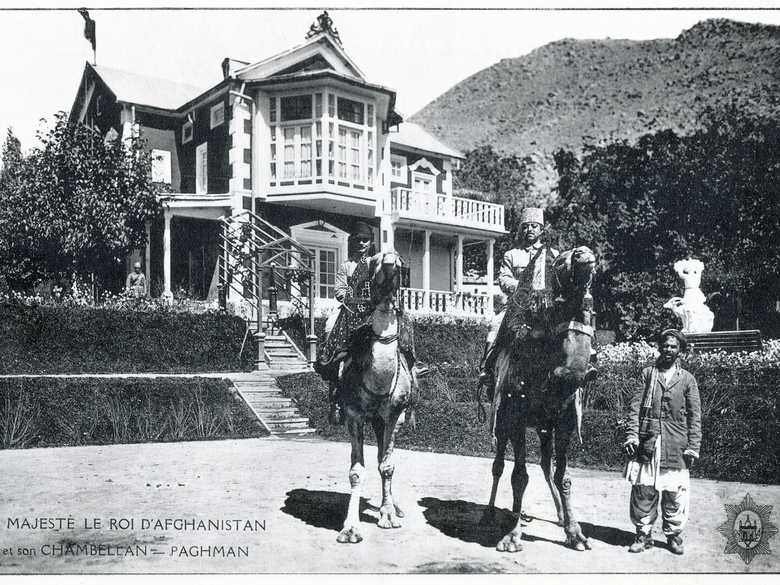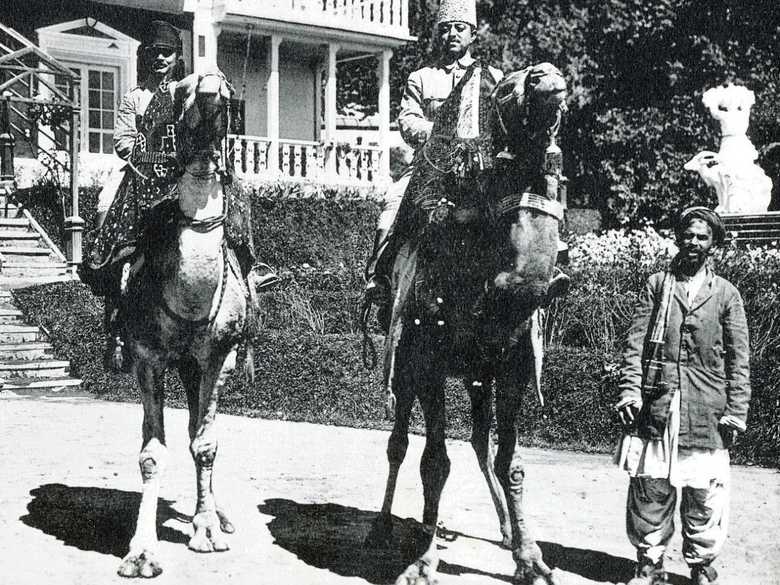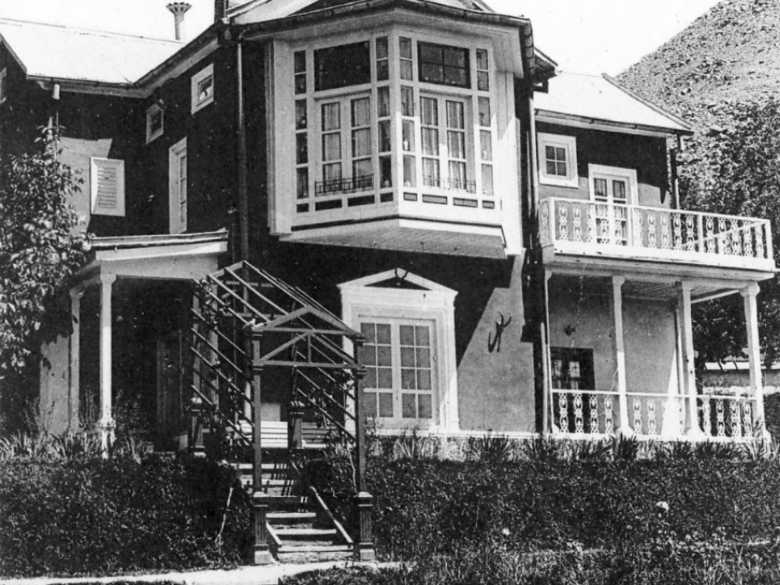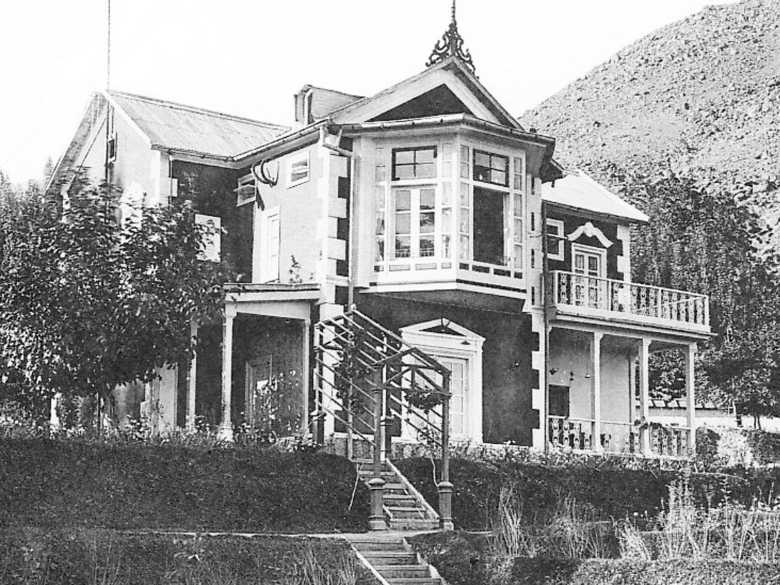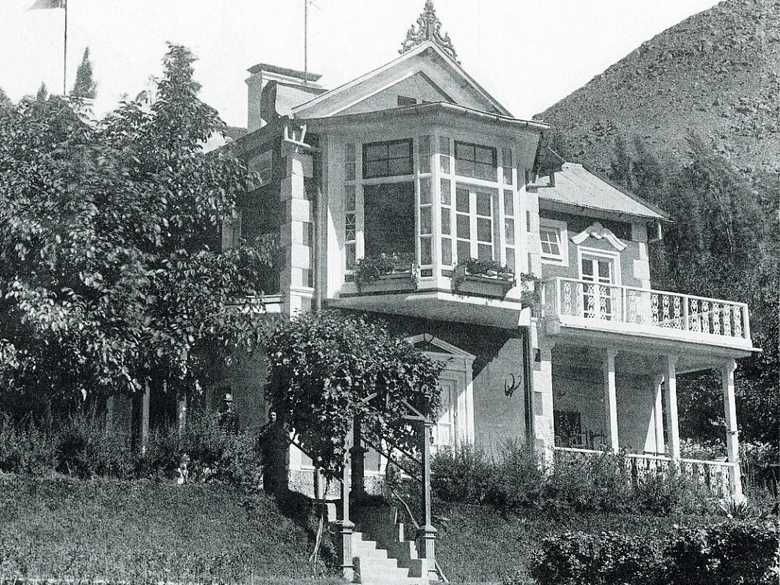SdA 3-033 — Amanullah Khan devant son palais koti sorkh
S.M. le roi Amanullah Khan (1892-1919-1929-1960), fils de l'émir Habibullah Khan (11.1.1.2), né le 1 juillet 1892 à Paghman. Il est à dos de chameau devant son palais koti sorkh (maison rouge) dans le domaine bala bagh à Paghman, portant une uniforme militaire et une kolah. A côté de lui son chambellan Shah Wali Khan, fils de Mhd Yusuf Khan (15.2.2), portant un képi. A côté d’eux, un serviteur en shalwar-khamis et turban. La photographie est dominée par l’oriel de la villa, d’une structure en verre et bois. A droite, derrière la haie de rosiers, une œuvre de l’artiste hongrois Farago, nommée «Der reiche Lohn - Fruchtbarkeit» (cf. la riche récompense – la fertilité), composée d’une fille et d’une chèvre. Tout à droite, une colonne portant une figurine. Devant la porte d’entrée, en haut, un officier afghan ; à gauche, un homme en tenue civile.
SA MAJESTE LE ROI D'AFGHANISTAN / et son CHAMBELLAN – PAGHMAN
- Souvenir d'Afghanistan, série 1 (petit format) : n’y figure pas.
- Souvenir d'Afghanistan, série 2 (grand format), SdA 2-40 : identique.
- Thomas, L. (1925) : Beyond Khyber Pass, p. 208 : deux illustrations montrant Amanullah et son entourage en haut sous la statue de Farago.
- Collection Espace Albert Kahn (1928) : série Afghanistan, Frédéric Gadmer, inv. A 58569 D (6112), photographie en couleur prise le 16.10.1928 : exactement la même vue du koti sorkh, prise quelques années après SdA 3-036.
- Collection Espace Albert Kahn (1928) : Série Afghanistan, Frédéric Gadmer, inv. A 58595 D (6119), photographie en couleur prise le 16.10.1928 : vue frontale et proche de la statue.
- Adamec, L.W. (1975) : Who’s who, pp.118-9 : Amanullah Khan ; pp. 236-7 : Shah Wali.
- Dupree, N.H. (1977) : Early 20th Century Afghan Adaptations of European Architecture, p. 20 : «[…] Elsewhere, particularly in the summer resort of Paghman in the hills above Kabul where the majority of private villas were constructed, structures were most commonly two-storeyed. Porches over porticos and balconies were popular; bay and oriel windows made their first appearance. […]»
- Dupree, N.H. (1980) : A Building Boom in the Hindukush, Afghanistan 1921-1928, p. 116 : «In the Bala Bagh (High Garden) at Paghman, a tall wall divided the King's official quarters, containing his office called Kot-i-Surkh (Red House), from his private residence. Kot-i-Surkh was the first building to incorporate an oriel window and two-storey veranda, two elements which subsequently enjoyed great popularity. At Kot-i-Safeed (White House), a residential-guest house just north of the office, massive two-storeyed 5-window bays were dominated by ornate round windows with foliated scrolls decorating the spandrels suggestive of Amir Abdur Rahman's period. Two years later when the two-storey residence was constructed in Bala Bagh, square Germanic towers were combined with oriel and bay windows. The royal apartments were located upstairs on the south side, while the rest of the building contained long rows of bedrooms and was, in effect, simply an elongated modification of the traditional haremserai for, although the King had only one wife, many ladies of the royal family made their home with him. Servants' quarters were located in the basement. Hidden among the bowers of the terraced gardens were several pavilions, fountains, tennis courts and a swimming pool, in addition to garden statuary made entirely from brick finished with gypsum plaster to simulate marble. Such statuary was a novelty, and those in human form created controversy among the King's conservative subjects who accused him of becoming an idol worshipper.»
- Adamec, L.W. (1985) : Kabul and Southeastern Afghanistan, p. 614 : Paghman.
- Adamec, L.W. (1987) : A Biographical Dictionary, pp. 18-19 : Amanullah, King ; pp. 173-174 : Shah Wali, Marshal.
- Adamec, L.W. (1991) : Historical Dictionary, pp. 28-29 : Amanullah, King ; p. 214 : Shah Wali, Marshal.
- Schinasi, M. (2008) : Kabul 1773-1948, p. 164 : concernant la carrière de Shah Wali ; concernant les constructions nouvelles à Paghman, p. 133 : «[…] A Paghman, où des dizaines de villas sortirent de terre, on assista à des combinaisons étonnantes de styles et de motifs architecturaux et décoratifs, rehaussées par les teintes pastel des badigeons extérieurs ; […]»
You know more about this picture?


